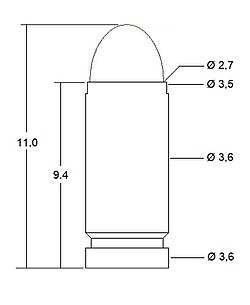| 2.7mm Kolibri | ||||||||
|---|---|---|---|---|---|---|---|---|
 2mm Kolibri cartridge dimensions | ||||||||
| Type | Centerfire ammunition | |||||||
| Place of origin | Austria-Hungary | |||||||
| Production history | ||||||||
| Designer | Franz Pfannl | |||||||
| Designed | 1914 | |||||||
| Manufacturer | Kolibri | |||||||
| Produced | 1914 | |||||||
| No. built | ~1000 (pistol)[1] | |||||||
| Specifications | ||||||||
| Case type | Rimless, straight | |||||||
| Bullet diameter | 2.7 mm (0.11 in) | |||||||
| Neck diameter | 3.5 mm (0.14 in) | |||||||
| Base diameter | 3.6 mm (0.14 in) | |||||||
| Rim diameter | 3.6 mm (0.14 in) | |||||||
| Case length | 9.4 mm (0.37 in) | |||||||
| Overall length | 11 mm (0.43 in) | |||||||
| Ballistic performance | ||||||||
| ||||||||
| Source(s): Cartridges of the World [2] | ||||||||
The 2mm Kolibri (also known as the 2.7mm Kolibri Car Pistol or 2.7×9mm Kolibri) was the smallest commercially available centerfire cartridge,[3] patented in 1910 and introduced in 1914 by Franz Pfannl, an Austrian watchmaker, with financial support from Georg Grabner. It was designed to accompany the Kolibri semi-auto pistol or single-shot pistol, both marketed as self-defense weapons, but somewhat underpowered.
The name is derived from Kolibri, the German word for hummingbird, which is among the smallest of birds.
- ^ Cite error: The named reference
pm2017was invoked but never defined (see the help page). - ^ Cartridges of the World 11th Edition, Book by Frank C. Barnes, Edited by Stan Skinner, Gun Digest Books, 2006, ISBN 0-89689-297-2 pp. 315, 530
- ^ Barnes, Frank C. Cartridges of the World. DBI Books, 1976, p.146